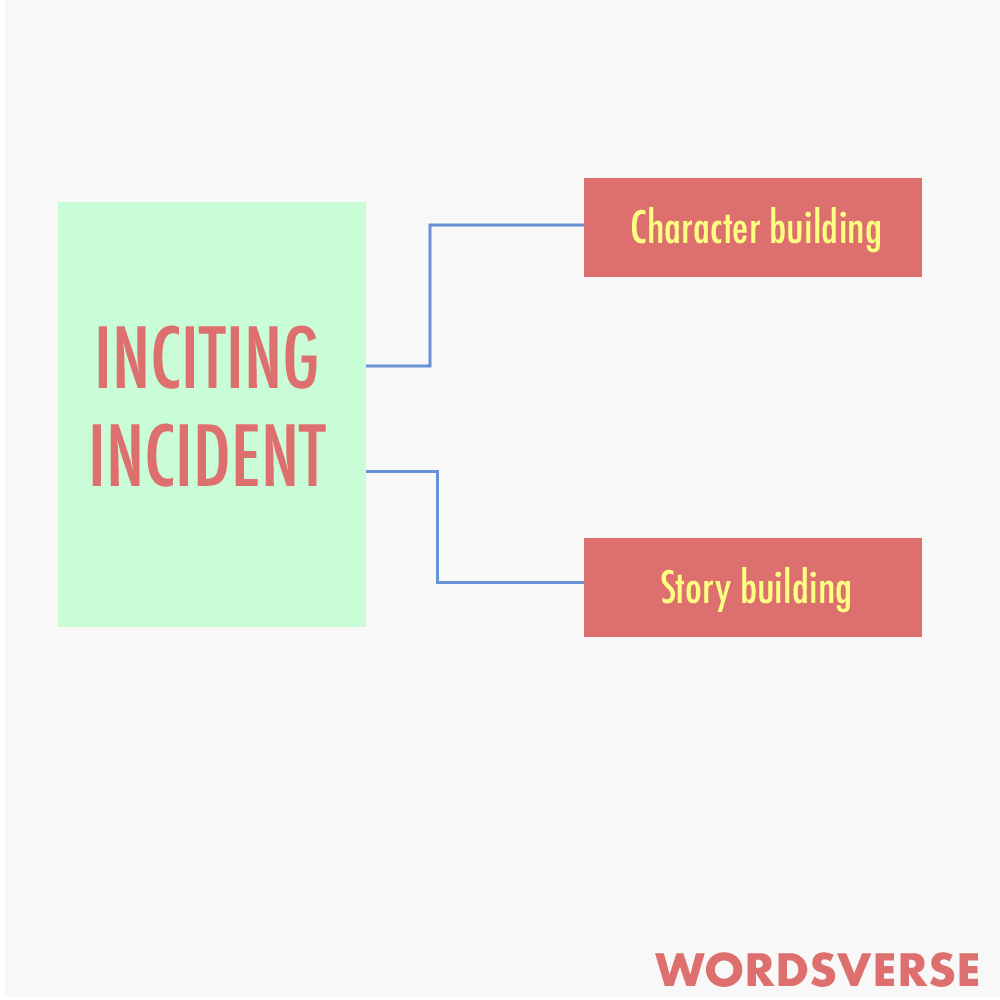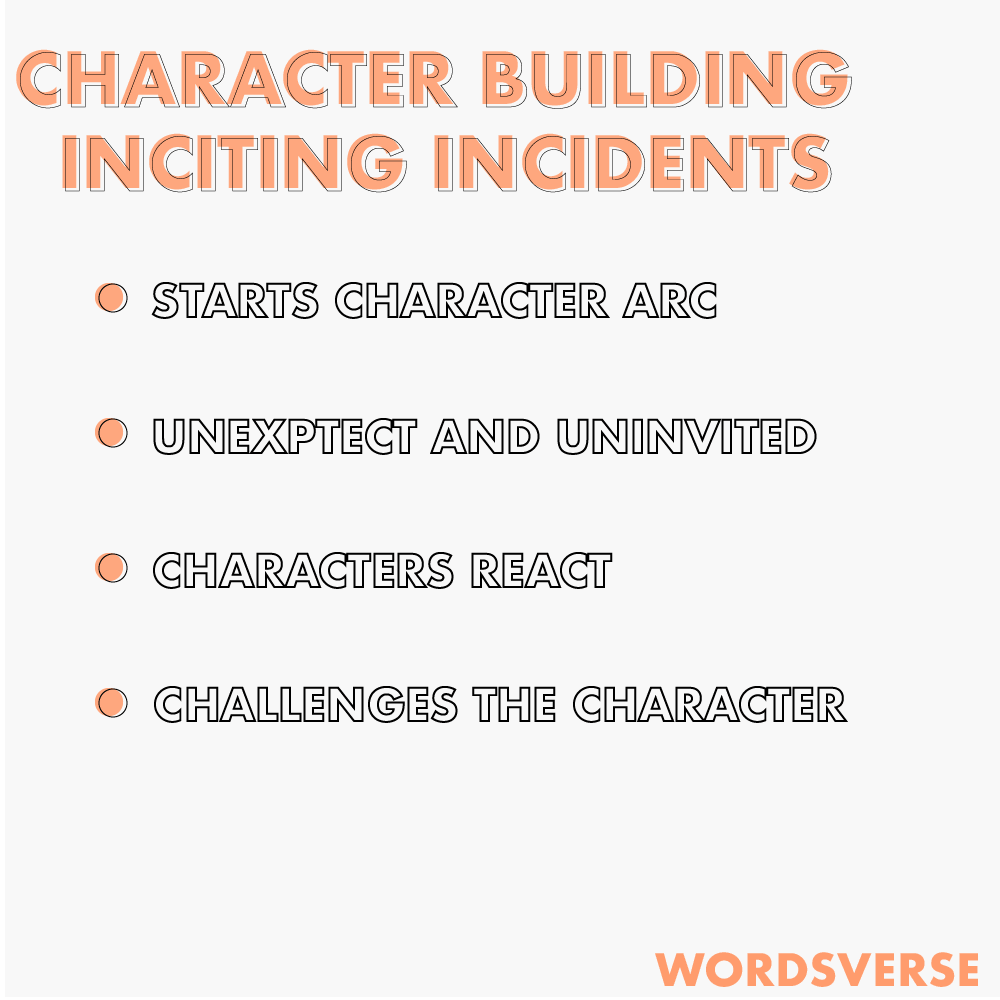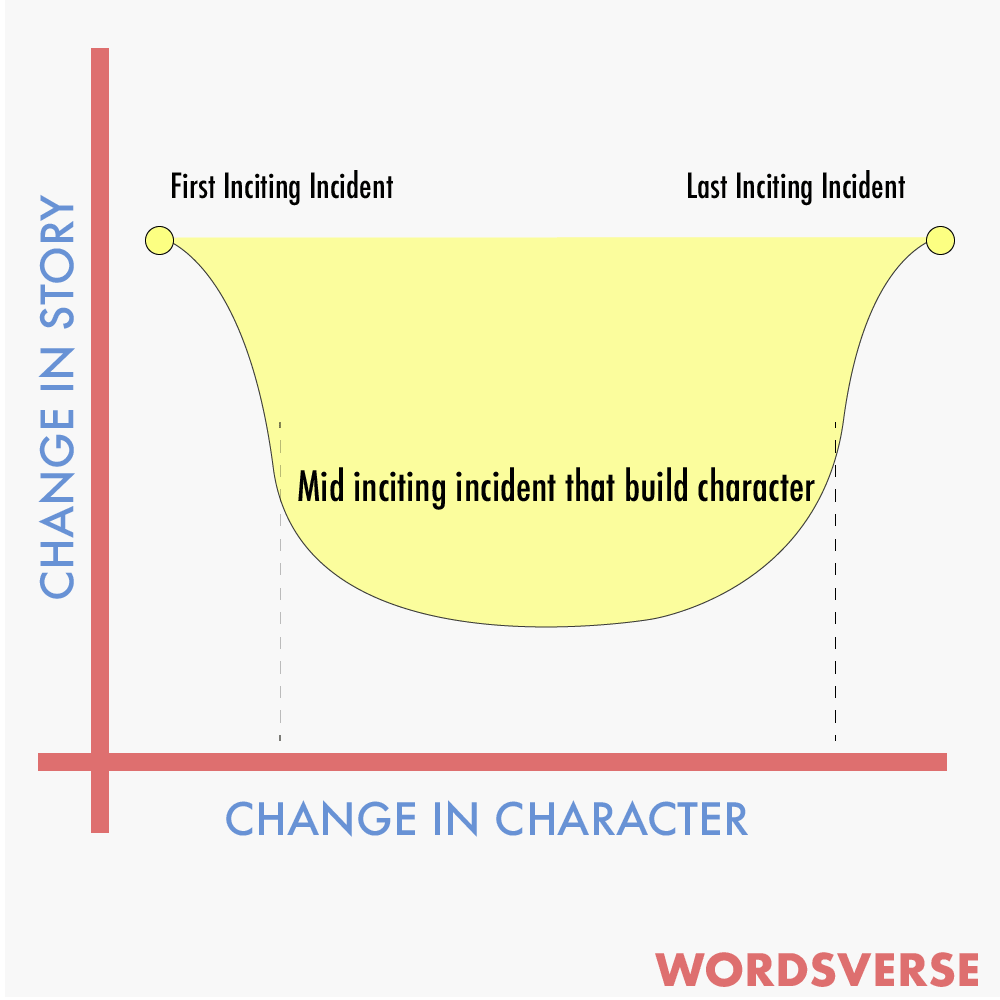Each story that is written, spoken, or shown has a pacing to it. This pacing means how the story develops. Is it slow? Is it too fast? Do exciting things take too much time to come into the spotlight? This exciting event in a story that peaks readers’ interest is what’s called an inciting incident. And contrary to what most people say, there must be inciting incidents in your story, not just one incident.
What are the inciting incidents? When should these events occur in a novel and does it depend on the genre of the novel? Everything will be answered in this article. We shall also look at the purpose of inciting incident, its necessity in the story, and how it is different from the climax, theme establishment, and the hook.
What does this article contain?
- What is an inciting incident in a story?
- Dividing the story before and after the inciting incident
- Tips to create a great inciting incident.
- Why you need more than one inciting incident
- Difference between multiple inciting incidents
- Anchor incidents and influencing incidents
What’s an inciting incident?
By the definition of it, inciting incidents is something that triggers a violent or unlawful behavior. These events change something important. But in writing lingo, it refers to something very different.
In a story, an inciting incident is something that happens to the protagonist and it puts the story in action. It could be anything that has an impact on the protagonist and alters the flow of the story, for better or for worse.
Examples of some inciting incidents in novels and movies include;
- Peter Parker gets bitten by a radioactive spider and it completely alters the story trajectory.
- In Murakami’s 1Q84, Aomame gets inside the tunnel and emerges into a different world, with its history.
- In The Lord of the Rings, Frodo and team heading for Mount Doom is the inciting incident.
- A Song of Ice and Fire has the murder of John Arryn as the inciting incidents (but there’s more to it)
- In Gone with the Wind, the arrival of Rhett Butler is the inciting incident for Scarlett, the protagonist.
From the examples above, you can get the idea of what inciting incidents do. They set the story in motion. If your story is a vehicle, everything before the inciting incident is checking the tires, the fuel, the steering, sitting inside, etc. The inciting incident is starting the car and pushing the accelerator.

What happens before the inciting incident
If inciting incidents put the story in motion, what happens before that? Before you start moving, writers must establish the setting, the characters, the beginning of their character arc, etc.
In terms of acts, the story’s establishment should happen in the major parts of the first act. Why is it necessary? Because inciting incidents to create a major change in the story. And if the “life before” is not established, the change is not impactful. This weakens the story.
So before you set the story in motion, establish the world, the problems, the life, the characters, etc. This is how life used to be before the major event occurred and changed everything. Now let’s see how to create great inciting events.
What great inciting incidents have?
While stories are remembered because they are unique, almost every story follows some guidelines that their genres have. Similarly, the inciting incident in your story will be as original and unique as your story, but the underlying structure must have all these attributes to let it stand on itself.
We have piled these aspects of the events based on the effect they have on the story. There’s character building and story building.
These are the qualities inciting incidents should have:
These four are the character-building events that progress the character arc and develop the character
It must start the character arc
The event is called “inciting” because it has the gravity to make the protagonist change. Whatever life he/she was living before the incident did not alter his/her character. This event is important and interesting because it changes that.
So the first inciting event in the story starts the character arc of your protagonist. Perhaps the protagonist is a lazy person and something happens that pushes him to start working. Here the character arc is this person struggling and changing to become better. The event began the character arc.
It’s unexpected, uninvited.
The event comes in the life of the main character like a storm, unasked, and uninvited. This is why it is inciting. In real life, what we do is all planned and there’s hardly a gravity to it. We do not influence it.
But when something unexpected happens, it impacts us, makes us wanna adjust to the change, good or bad. You get a promotion and now are the senior. This puts you out of your comfort zone; more work, more management.
Similarly, if you lose your job (I hope not), this also puts you out of your comfort zone. And in both cases, you must work to make things better.
In the movie Finding Nemo, Nemo gets abducted and this starts the movie. Notice how it was unexpected and put Marlin out of his comfort zone, thereby starting his character arc.
There’s hardly any example (not that I can find, do comment if you have any) where the inciting incident is brought deliberately by the character(s).
Shows the character’s reaction
A great inciting incident must elicit a reaction from the characters. This is important because as a writer, you want to show the readers more about the kind of person the protagonist and the other characters are.
All the characters get in an uncomfortable zone and their choices, their reactions define the character they have. This establishes what kind of people they are which is important for the character arc.
Using the previous example, in Finding Nemo, the inciting incident was Nemo getting abducted. This started Merlin’s character arc. It put him in an uncomfortable zone. But it was also important to see how he reacted, based on the established character. He swam frantically and decided to go on this journey with little or no hope, yet persevering in this journey to find Nemo.
Challenges everything about the protagonist
This is an oft confusion part of the whole process. The event that pushes the protagonist out of the comfort zone leads to events that challenge everything about the protagonist. This is the perilous journey that the protagonist takes which develops his/her character.
The inciting incident does not challenge everything about the protagonist, it just gives the character a push. The challenges come after that.
Again going back to the ocean, Marlin took the journey of finding Nemo, and then everything that happened to him challenged all his character’s aspects. A timid, scared clownfish who runs away from everything remotely dangerous has to fight sharks, a cluster of bombs, jellyfish, whales, angler fish, and even humans!

These were the inciting incidents that developed the character. Now let’s look at the events that develop the story.
Articles to help you write better:
- Why use narrative tension and why is it needed for your stories?
- Create great character arcs using this exclusive character arc template
- Using the five-step finale to craft great climax
Events show theme and tone of the event
Inciting incidents are not merely there to make your character suffer. Their purpose is also to advance the story and make it interesting. They reveal your vision and concept of the story, telling the readers why they should continue flipping the pages.
But what is the theme and tone of these events? The inciting incidents must be congruent with the theme and tone of the entire story. An example shall elucidate the point;
Suppose you are writing a murder mystery. The theme here is a mystery, so the inciting incident should be along the lines of “a murder happened but in a way that makes it impossible to decode”. This is evoking mystery.
For the tone, remember this is a murder. If you want your story to have a gritty, dark mystery, then the murder must be heinous, disgust-inducing. A light-hearted murder mystery would include just a murder.
This was an example to get the point across. A sci-fi story must have a problem that’s based on science. Adventure stories must have some sort of perilous journey.
In The Lord of the Rings, Frodo and the team take a journey that might end up killing them, but that’s the theme of the story, fantasy-adventure. The inciting incident was the journey. The incident cannot be Frodo falling in love with some she-hobbit and then struggling to go on a date.
When does the inciting incident happen?
A dilemma that many writers face is when to bring that inciting incident? The answer to this will be very ambiguous because it is highly dependent on the story and the genre of the story you are writing.
First, the story that you are writing has a lot to do with when the incident occurs. Have you established the characters, their traits, their choices? Have you established the world, the characters, and the problems the protagonist is facing? Before you start the story, it is important to establish everything before it. And this establishment depends on the genre of the story.
In superhero stories, like Spider-Man, the establishment is short and quick. Peter Parker is a nerd who’s got no game at all. This changes suddenly with the spider bite. The readers did not need an extended look into the life of Peter Parker before the bite because it was unnecessary and boring. They want to know what happens once he becomes Spider-Man.
But in a fantasy story, the inciting incident takes time. This is because of the scope of the story. The enormous world building, the characters, and their traits. The build-up of imminent problems, etc.
In The Lord of the Rings, once Gandalf the Grey discovers the ring, he takes his time to find more about it. And all while this happens, we learn about the Shire, about life, etc. It takes Gandalf 17 years to return and get the story started. 17 years!
In a murder mystery, the inciting incident happens very soon, within the first three chapters. This is because the readers are hoping to unravel the mystery and see the protagonist tackle challenging situations. Taking too long for inciting incidents to happen will bore the readers.
Romance is a genre where the range is the broadest. In some stories, it happens very quickly and then the plot progresses, While in some, the characters take a long time to meet.
Here’s what you should keep in mind;
- When the inciting incident happens depends on the writing style
- It also depends on the genre of the story
- Make it happen too late and you bore the readers, but a solid foundation is established.
- Make it happen too fast and readers don’t have a good idea about what happened before.
- Find the sweet spot with practice. Keep the pre-incident portion interesting with a few mysteries here and there.
Create mystery
A debate going around all the time is whether the inciting incident should present questions or answers to the readers? Again, it depends on the story, but there’s more to it.
Sometimes it should create questions both for the protagonist and the readers, as in murder-mysteries, horror, etc. Sometimes, they present questions to just the protagonist, as in adventure, romance, comedy.
But when should inciting incidents create answers? This will be answered in the latter part, where I explain why one inciting incident is not enough for a story.
What I found is there should be a healthy mix of mysteries both for the readers and the characters which keep the readers guessing at what happens next and sometimes it makes them anticipate what’s about to happen.
Urgency
Another great tool to make inciting incidents more inciting and effective is by putting a time constraint on it. The protagonist better act quick or everything will be lost. This motivates the characters to do things and do them quickly. It ups the adrenaline. Time constraint is most prominent in murder-mystery/thriller stories and subtler in other genres such as romance, adventure, etc. But there’s always a constraint in time to get things done before everything is lost.

Why stories need more than one inciting incident
No great, complex, and interesting story have just one inciting incident. Your story must have multiple inciting incidents, however, there is a catch.
As already established, inciting incidents have the power to completely change the story that was running before the incident happen. In the Matrix, Neo is given the choice to either take the blue pill or the red pill. Notice how before this happened, the entire story was about a guy doing normal things? But does The Matrix has just one inciting incident?
I’ll do one better. Think of one novel or movie that has just one inciting incident and that’s it. Resolving that resulted at the end of the story, without any other conflicting parts. Can you think of it? There are stories like that, in the beginner section of writers’ stories archive.
Having one inciting incident makes the story one-dimensional, simple and end within 50-pages
People love rising conflict, challenges that seem impossible to overcome. And all of these require your story to have multiple inciting incidents.
How many inciting incidents?
To create a story that is thoroughly enjoyable for the readers, your story should keep introducing inciting incidents until the end of the story. But there’s a catch.
The first inciting incident which happens around the third quarter of the first act is the most powerful one in terms of changing the story. The first incident changes the story completely.
The second inciting incident changes the story but not as drastically as the first one did. The purpose of the second inciting incident is to make things more difficult for the protagonist. The majority of the subsequent inciting incidents (after the first major one) is focused on driving the character development further.
The final inciting incident also called the major twist, the final subversion or the climax before the hero overcomes it all and the conflict is resolved, is as powerful as the first inciting incident. This is because it changes the story completely.
Here are some examples for easier understanding;
- In Finding Nemo, encountering the sharks, swimming with jellyfish, meeting the turtles, fighting inside the whale’s mouth, etc are all inciting incidents that change Marlin’s character a little bit, driving his character arc. Towards the end, in the climax, Nemo running into the net, and Marlin letting him go shows the change in him and that is the final inciting incident, as powerful as the first one.
- In The Lord of the Rings, there are multiple inciting incidents after they leave for the perilous journey. Gandalf dying (this was huge), Boromir’s corruption, the hobbits separating, meeting Shelob are all inciting events, each driving the character development and the story. The final inciting incident is when Frodo has to throw the precious ring. This ended their journey.
- In Batman Begins, Bruce Wayne’s meeting Ra’s al Ghul was the inciting incident, but when faced with the choice to kill a man, Wayne went against Ghul. This was also an inciting incident that developed the character. Fighting other criminals in Gotham was inciting incidents. But in the end, when he had and took the choice to let Ghul die, that was the final inciting incident, ending the story that was started by Ghul.
- In Gone with the Wind, the arrival of Rhett Butler was the inciting incident that changed Scarlett’s life. Everything that happened to her later was inciting incidents, changing her bit by bit. In the end, her realization that Rhett is the one for her is the final inciting incident. The readers kept waiting for the moment when Scarlett will fall in love with Rhett. And when she does, Rhett leaves. This ended the story, started by Rhett.
So there should be multiple inciting incidents in your story, but the first one and the last one are the most powerful for the story, changing it completely. Your story must always have two major inciting incidents that begin and end the story.
The sub-inciting incidents, also called influencing incidents can be anywhere from five to fifteen, depending upon the length and the genre of the story. Make sure they change the character and move the story ahead.
The first one starts the story, the last one end what was started by the first one. All the inciting incidents in the middle focus on the character and their struggles and challenges.

Always remember to have multiple inciting incidents where everything in between the first and the last don’t alter the story much but alter the character a lot. This helps you craft a great, complex, and enjoyable story.
This concludes the article about inciting incidents. I hope that what we provided cleared all the doubts regarding this topic. Now go ahead and create a beautiful story.







